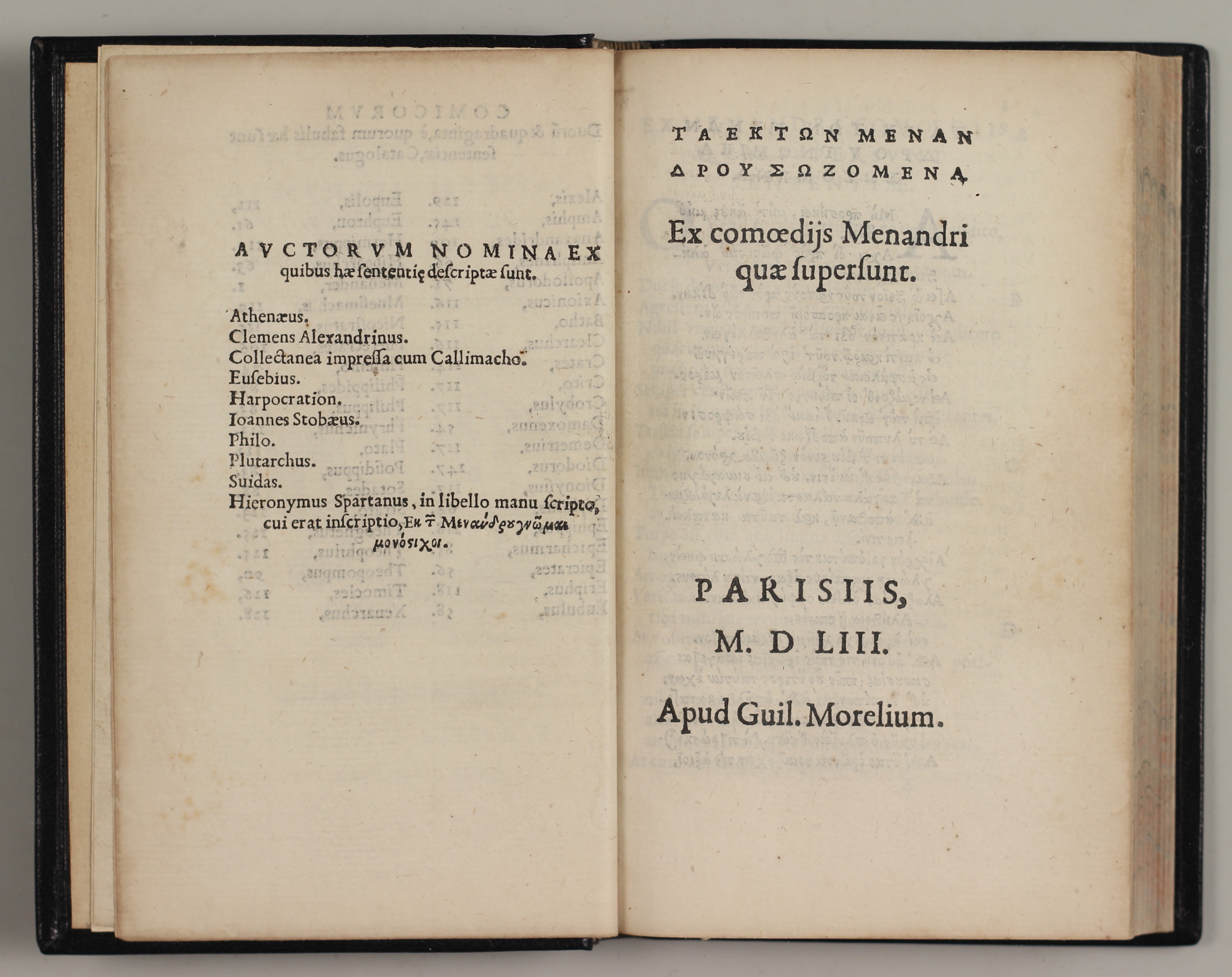Menander e. a.
Ex veterum comicorum fabulis … — Paris 1553/54
1.600 €Menander, Damoxenes, Epicratis, Eubulus, Euphronis, Diphilus, Apollodorus, Philemonis, Posidippus, Epicharmus, Philippidis, Sotadis, Theopompus, Antiphanis, Anaxandrida, Eupolidis, Cratetis, Nicostratus, Bathonis, Clearchus, Mnesimachus, Alexidis e.a.
Ex veterum comicorum fabulis, quae integrae non exstant, sententiae, nunc primum in sermonem Latinum conversae. — Parisiis, M.D.LIII. Apud Guil. Morelium.
[Second title-page (A1): Τὰ ἐκ τῶν Μενάνδρου σωζόμενα. Ex comoedijs Menandri quae supersunt. — Parisiis, M. D LIII. Apud Guil. Morelium.] [Colophon on penultimate leaf: Parisiis colligebat Guil. Morelius. M.D.LIII, on last leaf: Parisiis excudebat Guilielmus Morelius M.D.LIIII].
(Paris, G. Morel, 1553/1554).
Editio princeps
8vo (146 x 94 mm). Latin text: (2) leaves, pp. 147, Greek text: (74) leaves. Leaves of Greek & Latin alternate. To make it easier to find a passage, Morel has added the letters A, B, C, D in the margin of the Latin text at intervals of 8 lines each.
Type: Grec du Roy, 20 lines = 68 mm. Morel’s device on title.
Modern black morocco, spine and covers gilt. Last quire with a light watermargin in the upper part of the leaves.
On leaf *2 verso (Auctorum nomina ex quibus hae sententie descriptae sunt) Morel lists the printed sources for his edition in alphabetical sequence: Athenaeus, Clemens Alexandrinus, Collectanea impresso cum Callimacho, Eusebius etc. The last in this list however, though his name starts with H, is „Hieronymus Spartanus, in libello manu scripto, cui erat inscriptio, Εκ τοῦ Μενάνδρου γνῶμαι μονόστιχοι.“ In fact this Hieronymus is Georgius Hermonymos from Sparta, who arrived in Paris in 1476 and earned his living as copyist at the French court and teacher of Greek at Paris University with Budé, Erasmus, Reuchlin, Lefèvre d’Etaples amongst his students. Morel specifically points out that this source is a manuscript.
Kalatzi (see below) lists 4 manuscripts of Hermonymous including amongst other texts Menander’s Sententiae: Vienna: Vind. suppl. gr. 83; Aix-en-Provence: Bibliothèque Méjanes; Bibl. Apostol. Vaticana: Palat. gr. 122; Cracow: Bibl. Jagiellonska, Bero. oct. gr 20. I have no idea if any of these may have been the one Morel had in his hands.
On Hermonymos see Maria P. Kalatzi, Hermonymos. A Study in Scribal, Literary and Teaching Activities in the Fifteenth and Early Sixteenth Centuries, Athens 2009 (with focus on the manuscripts, JD). – Hoffmann II 590f.; Adams P-1692. The editions of the Sententiae by Jaekel (Leipzig, Teubner, 1964) and Pernigotti (Firenze, Olschki, 2008) do not discuss Morel’s edition though the Hermonymos manuscripts play a prominent role in the tradition of the text.



